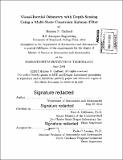Visual-inertial odometry with depth sensing using a multi-state constraint Kalman filter
Author(s)
Galfond, Marissa N. (Marissa Nicole)
DownloadFull printable version (9.989Mb)
Other Contributors
Massachusetts Institute of Technology. Department of Aeronautics and Astronautics.
Advisor
Paul A. DeBitetto and Paulo C. Lozano.
Terms of use
Metadata
Show full item recordAbstract
The goal of visual inertial odometry (VIO) is to estimate a moving vehicle's trajectory using inertial measurements and observations, obtained by a camera, of naturally occurring point features. One existing VIO estimation algorithm for use with a monocular system, is the multi-state constraint Kalman filter (MSCKF), proposed by Mourikis and Li [34, 29]. The way the MSCKF uses feature measurements drastically improves its performance, in terms of consistency, observability, computational complexity and accuracy, compared to other VIO algorithms [29]. For this reason, the MSCKF is chosen as the basis for the estimation algorithm presented in this thesis. A VIO estimation algorithm for a system consisting of an IMU, a monocular camera and a depth sensor is presented in this thesis. The addition of the depth sensor to the monocular camera system produces three-dimensional feature locations rather than two-dimensional locations. Therefore, the MSCKF algorithm is extended to use the extra information. This is accomplished using a model proposed by Dryanovski et al. that estimates the 3D location and uncertainty of each feature observation by approximating it as a multivariate Gaussian distribution [11]. The extended MSCKF algorithm is presented and its performance is compared to the original MSCKF algorithm using real-world data obtained by flying a custom-built quadrotor in an indoor office environment.
Description
Thesis: S.M., Massachusetts Institute of Technology, Department of Aeronautics and Astronautics, 2014. Cataloged from PDF version of thesis. Includes bibliographical references (pages 93-97).
Date issued
2014Department
Massachusetts Institute of Technology. Department of Aeronautics and AstronauticsPublisher
Massachusetts Institute of Technology
Keywords
Aeronautics and Astronautics.